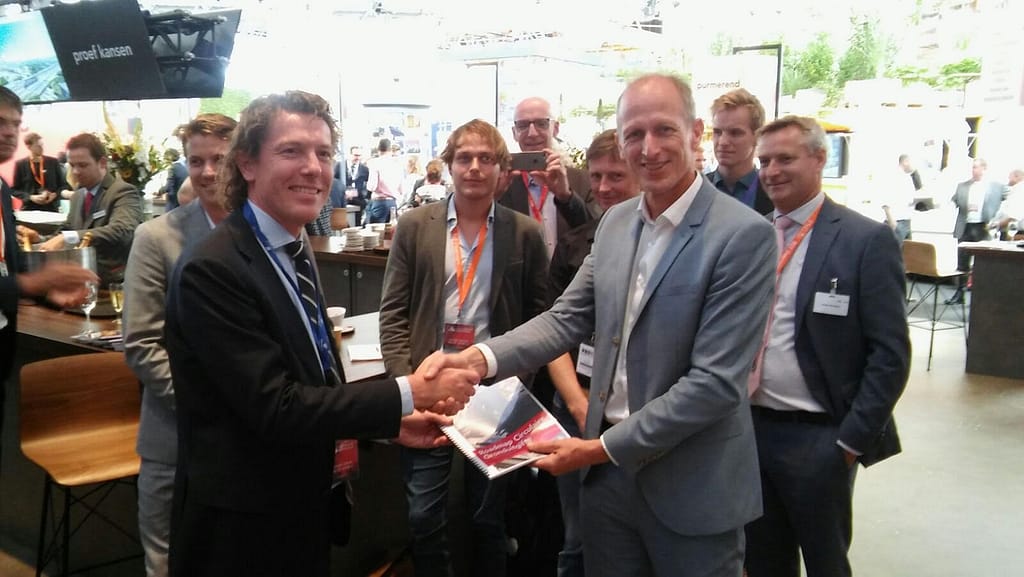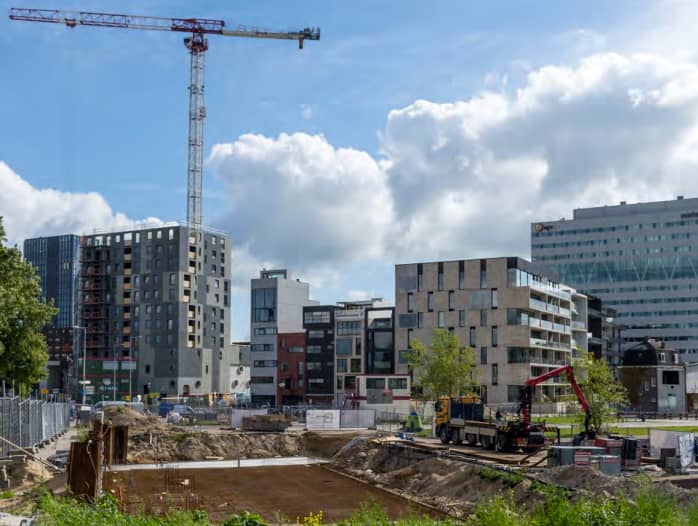Metabolic – together with our partners at SGS Search – has developed the world’s first roadmap for circular building tendering. Created for the city of Amsterdam, the roadmap was recently officially presented by the city to the Dutch Green Building Council as a marker of the city’s endorsement of its ideas. Here Metabolic consultant Merlijn Blok explains how this roadmap has the potential to fundamentally change the way we develop our built environment and why other cities, municipalities, housing corporations, and real estate developers should join Amsterdam in practically implementing circular tendering in new building developments.
Scroll down for Dutch version of this blog.
The way we designed our built environment in the past – in everything from school and offices to homes and hospitals – served us well for decades in housing a growing population and facilitating commerce and movement. However, it is now becoming increasingly evident that our approach has locked us into patterns of substantial and damaging social and environmental impact. Globally, the built environment is responsible for an estimated 60% of material use. In the Netherlands, buildings are responsible for 40% of everyday energy use and 25% of CO2 emissions. Construction and demolition activities in the Netherlands additionally account for 24 million tonnes of waste production, which is almost equivalent to industrial and consumer waste combined. And although 94% of this waste is currently recycled, this mostly occurs in downgraded form (such as debris for road construction).
A built environment that applies the principles of the circular economy is called for. But how do you practically transition the design and development of buildings so they not only mitigate against these impactful issues, but so that they also provide value and efficiently embed materials in long-term cycles? Many municipalities, cities and housing corporations struggle with this question. The answer is, as expected, not simple and even raises additional questions such as: How do we define a circular building? What are effective leverage points for accelerating this transition? And, crucially, what initial steps do we need to take to initiate this process?
At Metabolic, we have come up with an answer to this challenge. Through our work with SGS Search for the municipality of Amsterdam, this year we started practically implementing circularity in the built environment of the city of Amsterdam. Together, we developed a framework for circular building that defines and measures the circularity of a building, and provides criteria which may be used by municipalities and housing corporations to score buildings on their circularity performance. The circularity score of the building is based on Metabolic’s seven pillars of a circular economy to ensure an integral approach. The goals in these seven pillars are then defined through our four decision-making principles: reduce, synergize, supply, and smart management. By integrating these criteria in tender processes, circular innovation in housing development can be rewarded, and the transition to a more circular building sector can be stimulated. This way we aim to set a standard for circular buildings, to which all new stock will directly contribute.
In the development of the guidelines for circular tendering we have been working closely with both the municipality of Amsterdam and the market parties responsible for designing and constructing residential buildings. The criteria are performance based; leaving the question of how to most effectively reach a good sustainability and circularity performance to the market. By rewarding performance rather than means, we provoke innovation rather than confining it. We also limit the administrative burden and potentially costly procedures on both sides, by avoiding detailed designs or resource intensive evaluation processes. This ensures that both sides of the tender are incentivized to achieve ambitious circular performance. And by measuring this performance afterwards, each of these tenders will additionally yield valuable benchmarks for the circular performance of a building, which continually stimulates the market to perform better.
The most exciting part of this project is that we will initiate at least three circular tenders in Amsterdam, in which we put our guidelines into practice and circular buildings will be realized. In this way we will demonstrate the city’s ambition towards a circular built environment and the effectiveness of the roadmap developed by Metabolic and SGS Search to get there.
Although this project focuses on housing development in the city of Amsterdam, the roadmap we developed is flexible enough to be tailored to a broad range of building types and locations. This means it is scalable to many other cities in the Netherlands, and that is exactly the type of scale-up we are hoping to achieve: we are actively seeking opportunities to take this across the Netherlands to maximize its potential and impact. So if you are in the position of realizing housing and building projects and you share our vision of a circular built environment, then get in touch: we’d like to talk about how we can realize our shared vision.
To read the report find it online here (in Dutch).

Building a circular future: Annius Hoornstra, Deputy Director of Land and Development at the Municipality of Amsterdam presents the circular tendering roadmap – developed by Metabolic – to Derk Welling of the Dutch Green Building Council. The presentation took place at the international real estate conference Provada.
Een fundering voor circulaire bouw
Metabolic heeft – in samenwerking met onze partners van SGS Search – de eerste roadmap voor circulaire aanbestedingen ter wereld ontwikkeld. De roadmap is gemaakt voor de Gemeente Amsterdam en is recent door de stad gepresenteerd aan de Dutch Green Building Council, als onderschrijving van diens visie op de circulaire stedelijke omgeving van Amsterdam. Metabolic consultant Merlijn Blok legt uit hoe deze roadmap het ontwerp en de ontwikkeling van onze gebouwen fundamenteel verandert, en waarom andere steden, gemeenten, woningbouwcorporaties en vastgoedontwikkelaars zich bij Amsterdam zouden moeten aansluiten in het implementeren van deze circulaire aanbestedingen in nieuwbouwprojecten.
De manier waarop we in het verleden onze gebouwde omgeving hebben vormgegeven – van huizen, scholen, kantoorpanden tot wegen – heeft ons in staat gesteld een groeiende bevolking te huisvesten en economische activiteiten en mobiliteit te faciliteren. Het wordt echter steeds duidelijker dat dit ontwerp structureel schadelijke sociale- en milieueffecten met zich meebrengt. Globaal is de gebouwde omgeving verantwoordelijk voor ongeveer 60% van het materiaalgebruik. In Nederland zijn gebouwen verantwoordelijk voor 40% van het dagelijks energieverbruik en 25% van de CO2-uitstoot. Bouw- en sloopactiviteiten in Nederland produceren bovendien 24 miljoen ton afval, een hoeveelheid die bijna gelijk staat aan de gecombineerde jaarlijkse hoeveelheid industrieel- en consumentenafval. Hoewel 94% van dit afval momenteel wordt gerecycled, gebeurt dit voornamelijk in gedegradeerde vorm (zoals granulaat voor wegenbouw).
Er is kortom behoefte aan een gebouwde omgeving die de principes van de circulaire economie toepast. Maar hoe kunnen we het ontwerp en de ontwikkeling van gebouwen zodanig praktisch aanpassen dat ze niet alleen sociale- en milieuproblemen beperken, maar ook economische waarde creëren en materialen effectief inbedden in lange termijn kringlopen? Veel gemeenten, steden en woningcorporaties worstelen met deze vraag. Het antwoord is, zoals te verwachten, niet eenvoudig. Want hoe definiëren we een circulair gebouw? Waar in de bouwketen kan effectief invloed uitgeoefend worden om deze overgang naar circulaire bouw te versnellen? En wellicht de belangrijkste vraag: welke initiële stappen moeten we nemen om dit proces te starten?
Bij Metabolic hebben we een antwoord op deze uitdagingen. Door ons werk samen met SGS Search voor Gemeente Amsterdam zijn we dit jaar begonnen om circulariteit praktisch te implementeren in de gebouwde omgeving van de stad Amsterdam. Samen hebben we een raamwerk ontwikkeld dat de circulariteit van een gebouw definieert en meetbaar maakt, en dat criteria biedt die door gemeenten en woningcorporaties kunnen worden gebruikt om gebouwen al in de ontwerpfase te scoren op hun circulaire prestaties. De circulariteit score van het gebouw is gebaseerd op Metabolics zeven pijlers van een circulaire economie om een integrale aanpak te waarborgen. De doelen binnen deze zeven pijlers worden vervolgens bepaald aan de hand van vier aanvullende principes: reductie, synergie, inkoop en levering, en slim management. Door deze criteria te integreren in aanbestedingsprocessen kunnen circulaire innovatie in woningontwerp beloond worden, en kan de overgang naar een meer circulaire bouwsector gestimuleerd worden. Op deze manier streven wij ernaar een nieuwe standaard vast te stellen voor circulaire gebouwen.
Bij de ontwikkeling van deze richtlijnen voor circulaire aanbestedingen hebben we nauw samengewerkt met zowel de gemeente Amsterdam als de marktpartijen die verantwoordelijk zijn voor het ontwerpen en bouwen van woningen. De criteria zijn gebaseerd op prestaties, niet op middelen en methodes voor circulaire bouw. Hiermee laten we de vraag bewust open hoe duurzaamheids- en circulaire prestatie op de meest effectieve wijze kunnen worden bereikt. Zo dagen we de markt uit tot innovatie en competitie, in plaats van mogelijkheden in te kaderen en beperken. Door gedetailleerde ontwerpen of arbeidsintensieve evaluatieprocessen in een vroege fase van de aanbestedingsprocedure te vermijden, beperken we bovendien de administratieve lasten aan zowel de zijde van opdrachtgever als opdrachtnemer. Dit zorgt ervoor dat beide kanten van de aanbesteding worden aangemoedigd om ambitieuze circulaire prestaties te bereiken. En door deze prestaties achteraf te meten levert elk van deze tenders waardevolle benchmarks voor de circulaire prestatie van een gebouw, waarmee we de markt blijven prikkelen om constant mee te bewegen met deze best practices.
Het meest interessante onderdeel van dit project is dat we dit jaar tenminste drie circulaire tenders in Amsterdam zullen initiëren, waarbinnen we onze richtlijnen in praktijk brengen en circulaire gebouwen worden gerealiseerd. Op deze manier zullen we de ambitie van de stad voor een circulair gebouwde omgeving aantonen, en de effectiviteit van de roadmap – die laat zien hoe daar te komen en is ontwikkeld door Metabolic en SGS Search – demonstreren. We kijken er dan ook naar uit om de komende tijd in Amsterdam aan de slag te gaan met circulaire aanbesteding.
Hoewel dit project zich richt op woningontwikkeling in de stad Amsterdam, is de door ons ontwikkelde roadmap flexibel genoeg om op een breed scala aan bouwtypes en locaties af te stemmen. Het is kortom schaalbaar naar diverse andere steden in Nederland, en dat is precies wat Metabolic wil bereiken: we zoeken actief naar mogelijkheden in Nederland om het potentieel en de impact ervan te maximaliseren, en dagen eenieder met vragen rond circulaire huisvestings- en bouwprojecten uit om contact met ons op te nemen, opdat we een gezamenlijke visie voor een circulaire gebouwde omgeving kunnen realiseren.
Om onze rapport te lezen, klik hier.






